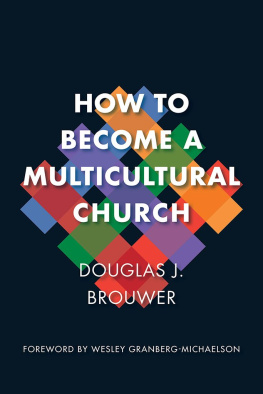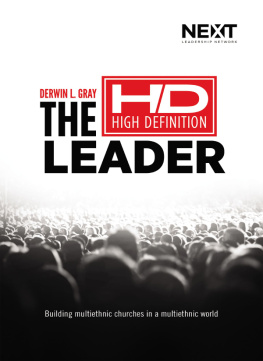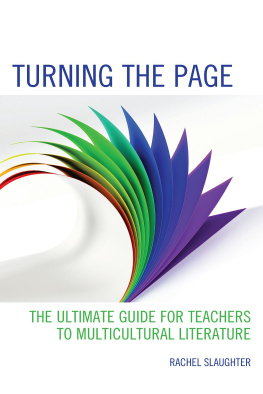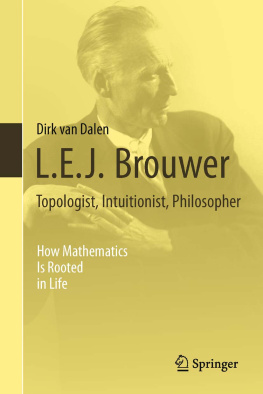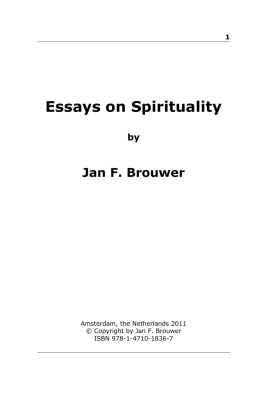HOW TO BECOME A MULTICULTURAL CHURCH
Douglas J. Brouwer
WILLIAM B. EERDMANS PUBLISHING COMPANY
GRAND RAPIDS, MICHIGAN
Wm. B. Eerdmans Publishing Co.
2140 Oak Industrial Drive N.E., Grand Rapids, Michigan 49505
www.eerdmans.com
2017 Douglas J. Brouwer
All rights reserved
Published 2017
23 22 21 20 19 18 171 2 3 4 5 6 7
ISBN 978-0-8028-7393-4
eISBN 978-1-4674-4782-9
Library of Congress Cataloging-in-Publication Data
Names: Brouwer, Douglas J., author.
Title: How to become a multicultural church / Douglas J. Brouwer.
Description: Grand Rapids : Eerdmans Publishing Co., 2017.
Identifiers: LCCN 2017008128 | ISBN 9780802873934 (pbk. : alk. paper)
Subjects: LCSH: Church. | Church and minorities. | Cultural fusion. | Church attendance. | CommunitiesReligious aspectsChristianity.
Classification: LCC BV600.3 .B75 2017 | DDC 250.8dc23
LC record available at https://lccn.loc.gov/2017008128
Contents
Authors usually write books without knowing the context that will exist when they are published. Sometimes a book appears in print that seems remarkably timely and relevant, but the author could not have predicted that when writing it. It can almost seem providential, like a gift provided through circumstances beyond anyones clever control.
Thats the case with this book by Doug Brouwer. Neither he, nor anyone, could have predicted the political and social climate existing by the time How to Become a Multicultural Church would arrive in bookstores. But a shaking of the foundations of prevailing, assumed multicultural commitments in several Western democracies has convulsed political life. Most dramatic was the election of Donald Trump, whose campaign and executive actions targeted those who were different, whether refugees or well-established immigrants, and manipulated legitimate economic anxieties of a dislocated white working class.
Demographic voting patterns revealed more dramatically than in any previous election the racial divide in the country. The 81 percent became the frequent and stunning point of reference, indicating the percentage of white evangelicals supporting Trump. But among evangelicals of color, the percentage more than flipped. The same pattern held true, though with somewhat different percentages, for Catholics, mainline Protestants, and others. Forces in the election galvanized racial bigotry in stark ways rarely seen in recent times.
The trend is evident not only in the U.S., but also in European Western democracies, where Brouwer carries out his ministry. Hostility toward immigrants and rhetorical appeals to preserve traditional English culture fueled the stunning passage of Brexit. And the political climate in the Netherlands, Germany, France, Hungary, and elsewhere has been jolted by an unexpected revulsion toward immigrants and others changing what is perceived as the homogeneous cultures of such countries. These movements champion resurgent nationalisms defined by various versions of ethnic homogeneity.
In all this, multicultural life in modern, democratic societies is under an unexpected attack. Forces thought to be confined to the extremes, like guerrilla fighters in remote mountains, have been sweeping toward capitals of power, and in some cases taking control. Extremism threatens to become mainstream, reshaping how social contracts are understood, overturning conventional political discourse, and intensifying social and cultural tensions.
One may wonder what Brouwers winsome, honest, and inspiring account of the International Protestant Church in Zrich, Switzerland, has to do with any of this. The answer is, a lot. In my view, the witness of the gospel in the world, and the focal point for Gods mission, always has its roots in the local congregation. Lesslie Newbigin put it best when he said, ... the only answer, the only hermeneutic of the gospel, is a congregation of men and women who believe it and live by it. If the witness and power of Christian faith is to be understood in the public square, it must be seen in the life of congregations shaped by its truth, just as it was first incarnated in a person.
Thats why How to Become a Multicultural Church is not some how to manual for tinkering with congregational life. Rather, its a survival guide for congregational witness in todays world. The book is rooted in the journey of a single congregation, uniquely positioned and comprised, striving to be a faithful hermeneutic of the gospel. That story is then amplified by Brouwers diverse pastoral experience, and by his fresh biblical interpretation and practical examples, which sustain this journey and will inspire others.
Multicultural congregations in the U.S. are slowly growing. Defined by a now-familiar benchmarkat least 20 percent of participants in the congregation are from a racial group other than the dominant majoritythey now comprise an estimated 13.7 percent of congregations. Yet, U.S. congregations are far behind the curve of changing demographics in society. For instance, the large majority of congregations are far less racially and culturally diverse than the schools their children attend, which is one reason why millennials often walk away from a church that doesnt come close to embodying the diversity they now assume and value in society.
Today, trying to become more multicultural is emerging as almost another congregational fad. Increasingly desperate for survival, congregations are likely to try anything. Its another in a list of pragmatic rejuvenation strategies, like increasing parking. Whats missed is that becoming more multicultural is no strategy at all, but rather at the heart of the churchs identity, and key to its missional potential.
Brouwer reminds us that building a worshiping community that crossed the boundaries of race and culture, first between Jew and Greek, became definitional of the New Testament church. Thats how people understood the reconciling power of the gospel. Further, the churchs mission to the world had its congregational roots not in Jerusalem, but in the church at Antioch, a dramatic example of a multicultural congregation. Such a living body of believers was, and is, a hermeneutic of the gospel.
We are now living in a time when true racial reconciliation and a shared multicultural life in society are questioned as not really being possible, and even undesirable. Such convictions, put plainly, are an affront to the gospel of Jesus Christ. They challenge directly the credibility and truth of Christian faith. So, the challenge is urgently raised, how is the church to respond? The answer must begin by a determination, simply, to be the church. If the messages of social evil which fuel racial and ethnic division in society are to be countered by the church, it must begin not simply with rhetoric, but with the demonstration that another social reality is possible.
The question, then, of How to become a multicultural church can be reframed as How to give witness to the gospel in todays world. Thats how to begin reading this book.
The congregation in Zrich, which provides a reference point for this narrative, is shaped, through geographical realities and spiritual mysteries, by the dynamics of world Christianity. In the world today, 244 million people have moved, or are moving, from one country to another for a wide variety of reasons. About half of this number are Christians, even though Christians comprise only one-third of the worlds population. The unrecognized story of global migration today is the massive movement of Christians which this entails.
This can, and should, dramatically impact congregational life. In a city like Zrich, with an international population, Christians from all corners of the globe seeking a church home visit the International Protestant Church. Its a microcosm of a dramatic global story. As author and friend Jehu Hanciles says, Every Christian migrant is a potential missionary.

